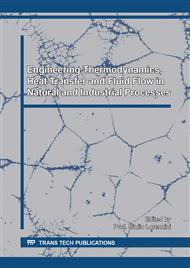[1]
P. Promvonge, S. Sripattanapipat, S. Tamna, S. Kwankaomeng, C. Thianpong, Numerical investigation of laminar heat transfer in a square channel with 45° inclined baffles, International Communications in Heat and Mass Transfer 37 (2010) 170-177.
DOI: 10.1016/j.icheatmasstransfer.2009.09.010
Google Scholar
[2]
R. Saim, H. Benzenine, H.F. Oztop, K. Al-Salem, Turbulent flow and heat transfer enhancement of forced convection over heated baffles in a channel Effect of pitch of baffles, International Journal of Numerical Methods for Heat & Fluid Flow 23(4) (2013).
DOI: 10.1108/09615531311323773
Google Scholar
[3]
H. Benzenine, R. Saim, S. Abboudi, O. Imine, Numerical study on turbulent flow forced-convection heat transfer for air in a channel with waved fins, Mechanics 19(2) (2013) 150-158.
DOI: 10.5755/j01.mech.19.2.4154
Google Scholar
[4]
K. Yongsiri, P.Eiamsa-ard, K. Wongcharee, S. Eiamsa-ard, Augmented heat transfer in a turbulent channel flow with inclined detached-ribs, Case Studies in Thermal Engineering 3 (2014) 1-10.
DOI: 10.1016/j.csite.2013.12.003
Google Scholar
[5]
S.S. Mousavi, K. Hooman, Heat and fluid flow in entrance region of a channel with staggered baffles, Energy Conversion and Management 47 (2006) 2011-(2019).
DOI: 10.1016/j.enconman.2005.12.018
Google Scholar
[6]
Y. Cao, L. Zhu, Y. Shi, Performance comparison of rod-baffle and segment-baffle heat exchangers using numerical simulations, Applied Mechanics and Materials 595 (2014) 128-133.
DOI: 10.4028/www.scientific.net/amm.595.128
Google Scholar
[7]
C. Chen, G. Cheng, H. Yang, Z. Hou, Physical modeling of fluid flow characteristics in a delta shaped, four-strand continuous casting tundish with different flow control devices, Advanced Materials Research 284-286 (2011) 1071-1079.
DOI: 10.4028/www.scientific.net/amr.284-286.1071
Google Scholar
[8]
C. Dong, Y. Chen, J. Wu, R. Cao, Numerical investigation on circumferential overlap trisection helical baffle heat exchanger, Applied Mechanics and Materials 389 (2013) 1035-1040.
DOI: 10.4028/www.scientific.net/amm.389.1035
Google Scholar
[9]
Xin Gu, Yongqing Wang, Qiwu Dong, Minshan Liu, Research on heat transfer enhancement of shutter baffle heat exchanger, Advanced Materials Research 236-238 (2011) 1607-1613.
DOI: 10.4028/www.scientific.net/amr.236-238.1607
Google Scholar
[10]
L. Xue-jiang, L. Rui, D. Yong, H. Su-yi, Experimental study on integrated performance for flower baffle heat exchanger's distance between two flower baffles, Applied Mechanics and Materials 29-32 (2010) 132-137.
DOI: 10.4028/www.scientific.net/amm.29-32.132
Google Scholar
[11]
L. Hui, Numerical study of flow and heat transfer of heat exchanger with louver baffles, Applied Mechanics and Materials, 721 (2015) 174-177.
DOI: 10.4028/www.scientific.net/amm.721.174
Google Scholar
[12]
H. Lu, W. Liu, T. Zhao, Study on the arrangement of baffles attenuating blast waves inside tunnels, Applied Mechanics and Materials 204-208 (2012) 1380-1384.
DOI: 10.4028/www.scientific.net/amm.204-208.1380
Google Scholar
[13]
N. Nagasubramanian, M.R. Thansekhar, M. Venkatesan, K. Ramanathan, Numerical investigation of natural convection in a square enclosure with a baffle mounted on vertical wall, Applied Mechanics and Materials, 813-814 (2015) 748-753.
DOI: 10.4028/www.scientific.net/amm.813-814.748
Google Scholar
[14]
X. Shen, J. Tan, Y. Li, Numerical study on the influence of cathode flow channel baffles on pem fuel cell performance, Applied Mechanics and Materials, 853 (2016) 410-415.
DOI: 10.4028/www.scientific.net/amm.853.410
Google Scholar
[15]
S. Sufang, Performance study of heat exchangers with continuous helical baffles on different inclination angles, Advanced Materials Research 655-657 (2013) 461-464.
DOI: 10.4028/www.scientific.net/amr.655-657.461
Google Scholar
[16]
H. Sun, C. Qian, An experimental investigation of the shell-side pressure drop of enlarged-hole whole-rounded baffle heat exchanger, Advanced Materials Research 160-162 (2011) 1622-1627.
DOI: 10.4028/www.scientific.net/amr.160-162.1622
Google Scholar
[17]
H. Sun, C. Qian, Experimental study of pressure drop and heat transfer of heat exchangers with lash baffles, Advanced Materials Research 199-200 (2011) 1523-1527.
DOI: 10.4028/www.scientific.net/amr.199-200.1523
Google Scholar
[18]
J. Sun, S. Cui, Z. Sun, Y. Kang, Numerical simulation of flow fields in different baffled flocculation reactors, Advanced Materials Research 550-553 (2012) 3037-3040.
DOI: 10.4028/www.scientific.net/amr.550-553.3037
Google Scholar
[19]
F. Yu, J. Wang, L. Xie, Hydrodynamic characteristics in ecological arc-shaped baffle fish way, Applied Mechanics and Materials 212-213 (2012) 1119-1122.
DOI: 10.4028/www.scientific.net/amm.212-213.1119
Google Scholar
[20]
Z. Xue-lian, L. Xian-sheng , L. Hong-fei, W. Yu-ning, Study on transverse baffle design parameters on influence of baffle anti-sloshing effect by fluent simulation, Applied Mechanics and Materials 404 (2013) 280-285.
DOI: 10.4028/www.scientific.net/amm.404.280
Google Scholar
[21]
A. Abedini, T. Armaghani, Ali J. Chamkha, MHD free convection heat transfer of a water–Fe3O4 nanofluid in a baffled C-shaped enclosure, Journal of Thermal Analysis and Calorimetry, 2018, https://doi.org/10.1007/s10973-018-7225-8.
DOI: 10.1007/s10973-018-7225-8
Google Scholar
[22]
M. Hamdan, M.A. Al-Nimr, The use of porous fins for heat transfer augmentation in parallel-plate channels, Transp Porous Med 84 (2010) 409-420.
DOI: 10.1007/s11242-009-9510-2
Google Scholar
[23]
Y.J. Hong, S.S. Hsieh, An experimental investigation of heat transfer characteristics for turbulent flow over staggered ribs in a square duct, Experimental Thermal and Fluid Science 4 (1991) 714-722.
DOI: 10.1016/0894-1777(91)90078-6
Google Scholar
[24]
R. Kamali, A.R. Binesh, The importance of rib shape effects on the local heat transfer and flow friction characteristics of square ducts with ribbed internal surfaces, International Communications in Heat and Mass Transfer 35 (2008) 1032-1040.
DOI: 10.1016/j.icheatmasstransfer.2008.04.012
Google Scholar
[25]
S. Skullong, S. Kwankaomeng, C. Thianpong, P. Promvonge, Thermal performance of turbulent flow in a solar air heater channel with rib-groove turbulators, International Communications in Heat and Mass Transfer 50 (2014) 34-43.
DOI: 10.1016/j.icheatmasstransfer.2013.11.001
Google Scholar
[26]
B.E. Launder, D.B. Spalding, The numerical computation of turbulent flows, Computer Methods Applied Mechanics Eng. 3 (1974) 269-289.
DOI: 10.1016/0045-7825(74)90029-2
Google Scholar
[27]
S.V. Patankar, Numerical heat transfer and fluid flow, McGraw-Hill, New York, (1980).
Google Scholar
[28]
J.P. Van Doormaal, G.D. Raithby, Enhancements of the SIMPLE method for predicting incompressible fluid flows, Numerical Heat Transfer 7 (1985) 147-163.
DOI: 10.1080/01495728408961817
Google Scholar
[29]
B.P. Leonard, S. Mokhtari, Ultra-sharp nonoscillatory convection schemes for high-speed steady multidimensional flow, NASA TM 1-2568, NASA Lewis Research Center, (1990).
Google Scholar
[30]
L.C. Demartini, H.A. Vielmo, S.V Möller, Numeric and experimental analysis of the turbulent flow through a channel with baffle plates, J. Braz. Soc. Mech. Sci. Eng. 26 (2) (2004) 153-159.
DOI: 10.1590/s1678-58782004000200006
Google Scholar


